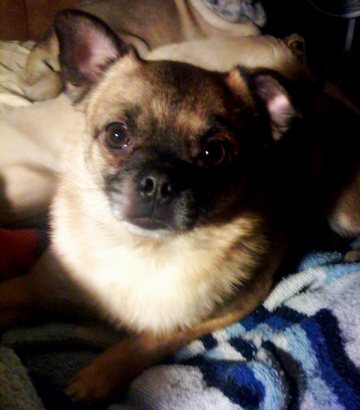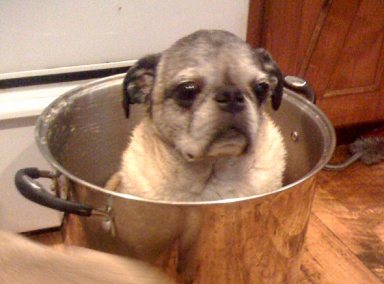It's often strange the things that inspire us.
In May of 1999, I was a broke college student slaving my way through my undergraduate degree, and grieving for the loss of my pug mix, Pugly. Then my family bought me Edgar T. Post.
Edgar was an 8 month old pug puppy with an almost manic enthusiasm for life, a penchant for mischief and a heart big enough to love the whole world. I think it is safe to say that Eddie has never met a stranger. He is patient with children and puppies, gentle and gentlemanly with the elderly, and equally enthusiastic about everything from lounging on the couch to going to the vet. (Going to the vet is Social Hour for the Edgar!)
Three years later, in 2001, I noticed that Ed seemed a little "off". It wasn't anything I could put a finger on, but he just wasn't "Edgarish". I told my veterinarian as much and got the "you've got to be kidding me" look. Edgar was not overly lethargic. His appetite was puggy normal. He was going potty fine, and there were no physical symptoms of distress. For all outward appearances Edgar was perfectly healthy. I insisted on a full blood workup. My vet humored me.
The results came back with a startling find... The blood work was positively diagnostic of Chronic Hepatitis. Edgar, the outwardly healthy pug, was in liver failure at the ripe old age of just under 3 years old. Chronic hepatitis is uncurable and prognosis is guarded... a handful of months to a handful of years in the best circumstances.
Additional diagnostics were run, testing for autoimmune issues. Often chronic hepatic conditions in dogs can be triggered by autoimmune thyroiditis (an autoimmune condition causing hypothyroidism), or Cushing's Disease (an autoimmune condition in which the adrenal gland over produces steroid hormones). To determine this we ran a thyroid panel and an ACTH Stimulation test (Adrenocorticotropic Hormone Stimulation).
Again the test results were startling.... Edgar did have thyroiditis. He did not have Cushing's. He had the exact opposite of Cushing's, a condition called Addison's. My vet suspected secondary Addison's, which meant that his adrenal gland was not being stimulated to produce sufficient steroid hormones.
It was bad news. We could start hormone therapy to offset the low thyroid, but the treatment for Addison's was contradictory to the goal of stabilizing his liver. To treat the Addison's we would have to give prednisone. In doing so we ran the risk of making his liver worse. But not treating wasn't an option. Addison's, if untreated, can rapidly be fatal, especially under physically stressful conditions such as serious illness.
To put it simply... If we treated him, we could kill him. If we didn't he could die. Either way we were in for a long, hard expensive road, and he probably wouldn't live that long anyway. Most of the people I knew were of the opinion that it just wouldn't be worth it.
But my family has a different mindset. To quote Galaxy Quest... "Never give up! Never surrender!" We wanted to treat and to my eternal joy, Dr. David Faulkner, of Hope Veterinary Clinic in Amarillo, Texas, was every bit as stubborn and reckless as we were. We dove headfirst into treatment, battling his liver enzymes back down onto the chart and then slowly into normal ranges, and hauling his thyroid and steroid hormones up out of the gutter.
Dietary support is an important part of liver disease management, and there are a number of commercial foods available for this. But again Edgar couldn't take the easy road. We had known since he was a year old that he was allergic to corn, and corn was the #1 ingredient in all the commercial liver diets. But my undergraduate degree was in Agriculture, and I'd had a number of animal nutrition and feeding courses. So I bought the Small Animal Clinical Nutrition textbook and once again threw myself headlong into the fray of creating a healthy, nutritionally complete diet for Edgar. (It's harder than you'd think!)
Three more years passed in a routine of pills, vitamins, cooking pug food, and 6 month blood tests. It was now the summer of 2006 and Edgar was 6 years old. He began to get lethargic, and he wasn't as enthused about eating as he should have been. We went to the vet for bloodwork.
It came back that he was anemic. His hematocrit, red blood cell count and platelet count were all low. We began to supplement him with more vitamins, and tested him again a few weeks later. His blood count had dropped even further. There was no sign of infection. We added more vitamins and tried different medication changes. His blood count continued to drop and his condition deteriorated with it. Dr. Faulkner felt we might have to resort to a transfusion in a last ditch effort. Edgar was dying one blood cell at a time.
Out of desperation I emailed my brother, who is a medical doctor for humans, outlining the situation and providing copies of the blood work. He emailed me back: Edgar had APS (Autoimmune Polyglandular Syndrome) and his Addison's was now primary. His adrenal glands had been destroyed by the autoimmune condition that caused his thyroiditis. We needed to add mineral cortoids to his treatment and increase his thyroid medication.
I ran back to my vet with Edgar and the information from my brother. We gave him an injection of DOCP, and upped his thyroid medication immediately. Within weeks Edgar's condition turned around. His blood count began to climb and his attitude improved. A monthly dose of DOCP was prescribed.
It's now 2010 and Edgar is still pugging along. We've definitely beaten the odds. It's not easy. It's not always smooth sailing. We have to watch for signs and make adjustments, and take great care to keep him stress free and properly medicated. I've had to learn to give shots and recognize the faintest of symptoms. And it's not cheap. Edgar's monthly DOCP alone is about $35 per .75ml dose. In good conditions he gets a full blood workup every 6 months. In bad conditions, it can be as often as every two weeks.
Edgar is worth it. I wouldn't trade a penny of the cost for a second of his life.
Because of Edgar, I know the horrible choice so many true pet lovers face... to fight for the life of a creature that is literally part of the family, or to cave to the crushing pressure of financial concerns. It's not a matter of "would we". It's a matter of "can we afford to?"
Having Edgar in my life planted the seed of a dream. A dream of a world where no one has to face that terrible choice. And that dream is slowly flowering into the Pug Hollow Foundation. Pug Hollow isn't a traditional rescue organization. We don't take in and adopt out healthy creatures. We operate solely on the basis of permanent fostering for those who are long term, terminal or critical care. We help people who are facing the terrible choice have options.
Currently Pug Hollow is a tiny organization struggling to overcome the cost of providing for the furkin in our care long enough to file for 501c(3) status. But someday soon, the pug who changed the world for me is going to change the world for a lot of others. Someday soon, Pug Hollow will help bring Heaven on Earth to a few more souls.
Because Edgar is worth it. And so are they.
 |
| Edgar T. Post gets into everything... even the Christmas Spirit! |





